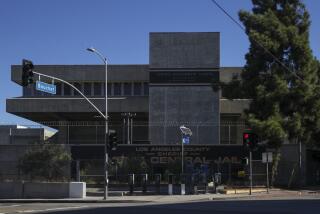Cause of Denny’s Injuries Disputed : Court: Doctor says the brick shown on videotape hitting the trucker in the head struck him behind the area where his skull was fractured.
- Share via
An Orange County plastic surgeon testified Wednesday that a brick thrown by a man prosecutors say is Damian Monroe Williams did not cause the extensive injuries trucker Reginald O. Denny suffered to his skull and face.
Dr. Leonard Prutsok said the brick allegedly thrown by Williams--in a sequence captured on videotape--landed above Denny’s ear. That impact point is behind an area where CAT scans show the trucker’s skull caved in. As one prosecutor put it, the blow left Denny’s head looking “as though a divot had been taken out” with a golf club.
Another brick could have caused Denny’s head injuries, said Prutsok, who was testifying as a witness for the defense.
Williams’ attorney, Edi M. O. Faal, maintains that a brick or some other object struck Denny while he was still in the cab of his truck, causing the trucker’s skull and facial fractures.
Williams, 20, and Henry Keith Watson, 29, are charged with attempting to murder Denny and with assaulting or robbing seven other people at Florence and Normandie avenues, the intersection where Denny was beaten as rioting broke out last year.
Deputy Dist. Atty. Lawrence C. Morrison could barely contain his incredulity at Prutsok’s testimony.
He produced sketches of a skull and face, pointing out the areas where Denny suffered fractures and noting that the plastic surgeon who treated the trucker said one brick could have caused all of the injuries.
Morrison then asked Prutsok if he were disagreeing with that physician’s assessment.
“I sort of am,” Prutsok answered.
Morrison produced a red clay brick and asked Prutsok to heft it. He then asked the doctor if that brick would cause a fracture if it were thrown at someone’s head from two feet away.
“Not every time,” Prutsok said.
“It seems odd that you wouldn’t expect a skull fracture every time,” Morrison said.
A brick thrown from that distance might cause a skull fracture only 30% to 40% of the time, Prutsok said. “You can’t say what one particular blow does to any individual,” he said.
Morrison presented an array of medical records, sketches and photos of Denny’s injuries, but Prutsok would not budge from his opinion that the brick shown on the videotape hitting Denny in the head struck behind the area where his skull was fractured.
Faal does not concede that the man who threw the brick is Williams, or that the object that hit Denny in the head was a brick. But whoever that person is, the object he threw did not cause the alleged aggravated mayhem, Faal said outside court.
Only Williams is charged with aggravated mayhem--intentionally causing permanent disability or disfigurement. Like attempted murder, aggravated mayhem carries a maximum sentence of life in prison.
In another development, Superior Court Judge John W. Ouderkirk ruled that a UCLA professor could testify about a sociological theory called “group contagion,” which holds that mob behavior during a riot is spontaneous.
According to the theory, riot actions are purely spontaneous and thoughtless--an argument that would rule out the criminal intent necessary to prove attempted murder and aggravated mayhem.
Ouderkirk said that he does not find the theory credible but that the jury has to make its own decision. The judge placed strict limits on what the professor, Dr. Armando Torres Morales, could discuss in his testimony.
Morales, who is to testify today, may explain group contagion, but he may not apply it to events at Florence and Normandie--nor may he discuss comparisons or causes of riots.
Morales does not know if anyone at the intersection felt exploited, or whether they may have had other motivations to do what they did, the judge said. In addition, the penal code prohibits Morales from presenting his opinion about anyone’s intent or lack of it, Ouderkirk said.
“The logical extension of Dr. Morales’ testimony, if believed and given weight, is that no one participating in a riot could be responsible for any specific intent crime such as murder, attempted murder, robbery, burglary or mayhem,” Ouderkirk said.
More to Read
Sign up for Essential California
The most important California stories and recommendations in your inbox every morning.
You may occasionally receive promotional content from the Los Angeles Times.













